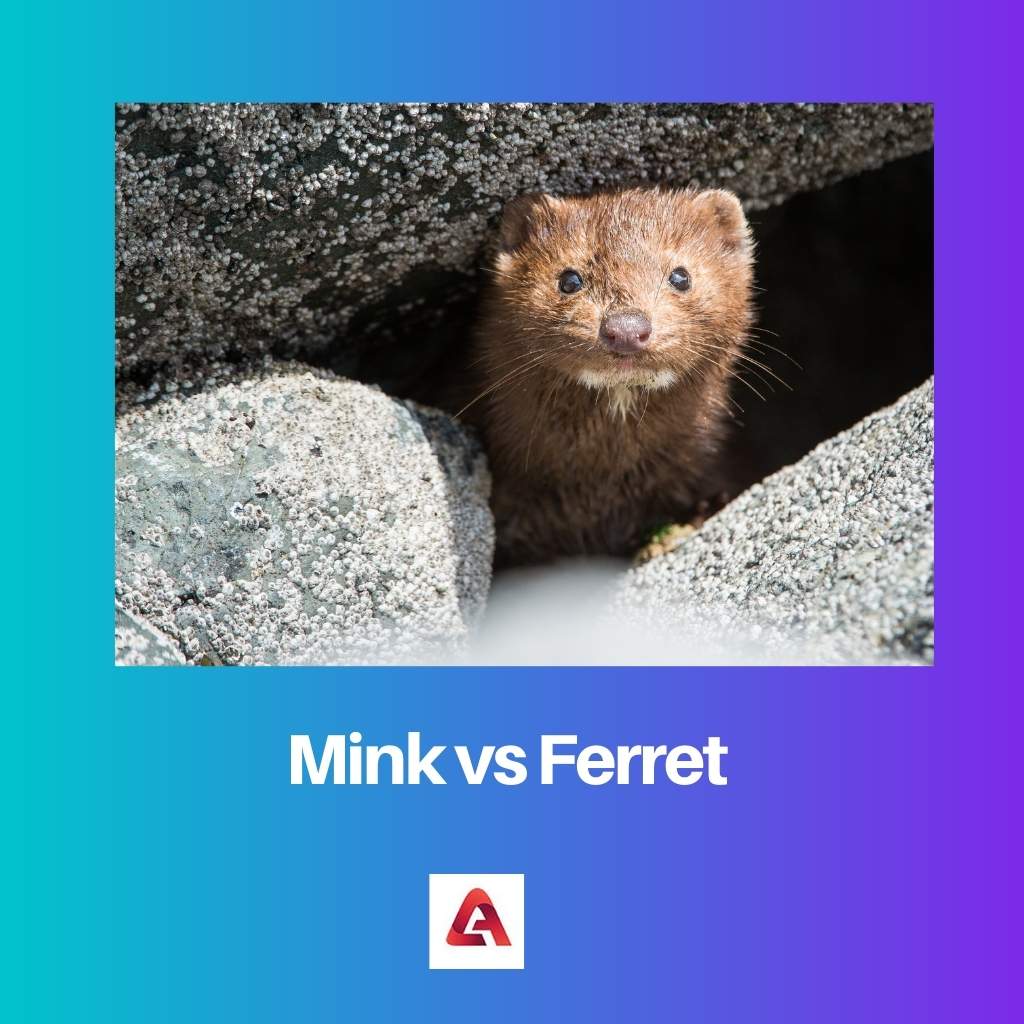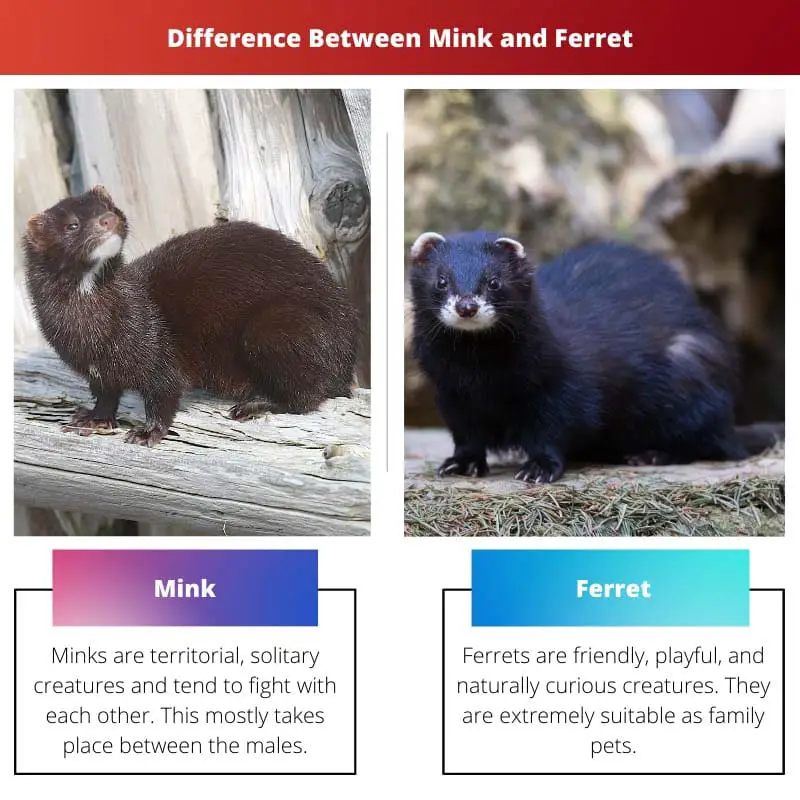The Mink and Ferret are both mammals belonging to the Mustelidae family. They are both carnivorous mammals and are somewhat similar-looking. Although both Mink and Ferret have some similar features, they differ from each other in many ways.
Key Takeaways
- Minks are larger and have a more pointed faces than ferrets.
- Ferrets are domesticated animals, while minks are found in the wild.
- Minks have a thicker and shinier fur coats than ferrets.
Mink vs Ferret
Minks are semi-aquatic mammals that are native to North America and Europe. They have a sleek body covered in thick, dark brown fur, webbed feet, and a long tail. Ferrets are domesticated mammals that have been selectively bred from the European polecat. They have a long, slender body, short legs, and a pointed snout.

Mink is a semi-aquatic carnivorous species of mammal belonging to the Mustelidae family. They are carnivorous creatures and feed on mice, frogs, birds, and eggs. Minks can dive up to a depth of 12 feet underwater.
As Minks are too wild to live in a domestic setting, they are kept in zoos or farmed for their beautiful, glossy fur. Captive minks need plenty of space and access to water to replicate their natural habitat.
Ferrets are sub-species of mammals belonging to the Mustelidae family. They are carnivorous creatures and feed on small prey like small insects, raw meats, and bones. Ferrets are friendly and naturally curious creatures.
Furthermore, they are intelligent and can be kept as house pets and trained by the owner. Ferrets do not require as much space as Minks and can comfortably settle in a family home for them to move around freely. However, Ferrets are illegal in some parts of the world.
Comparison Table
| Parameters of Comparison | Mink | Ferret |
|---|---|---|
| Type | Minks are carnivorous species of mammal. | Ferrets are carnivorous sub-species of mammals. |
| Temperament | Minks are not suitable as pets. They have to be maintained and kept in zoos or captivity. | Ferrets are friendly, playful and can be raised as family pets. |
| Behaviour | Minks are territorial, solitary creatures and tend to fight with each other. This mostly takes place between the males. | Ferrets are friendly, playful, and naturally curious creatures. They are extremely suitable as family pets. |
| Food habits | Minks are carnivorous and prefer to feed on big prey, like frogs, birds, mice, and eggs. | Ferrets prefer feeding on small prey like insects, raw meat, and bones. |
| Lifespan | Minks have an average lifespan of 9-11 years. | Ferrets have an average lifespan of 5-9 years. |
| Space | Captive minks need plenty of space and access to water to replicate their natural habitat. | Ferrets do not require as much space as Minks and can comfortably settle in a family home for them to freely move around. |
| Farmed | Minks are farmed for their beautiful, glossy fur. | Ferrets are not farmed. |
What is Mink?
Mink is a semi-aquatic carnivorous species of mammal belonging to the Mustelidae family. They are carnivorous creatures and feed on mice, frogs, birds, and eggs. Minks can dive up to a depth of 12 feet underwater.
Minks are territorial, solitary, nocturnal creatures and tend to fight amongst each other. This mostly happens between males. As Minks are too wild to live in a domestic setting, they are kept in zoos or farmed for their beautiful, glossy fur.
Captive minks need plenty of space and access to water to replicate their natural habitat.
Minks are carnivorous and prefer to feed on big prey, like frogs, birds, mice, and eggs. They have an average lifespan of 9-11 years and are farmed for their beautiful, glossy fur.

What is Ferret?
Ferrets are sub-species of mammals belonging to the Mustelidae family. They are carnivorous creatures and feed on small prey like small insects, raw meats, and bones. Ferrets are friendly, playful, and naturally curious creatures.
Furthermore, they are intelligent and can be raised as family pets and trained by the owner. Ferrets do not require as much space as Minks and can comfortably settle in a family home for them to move around freely. However, Ferrets are illegal in some parts of the world.
Ferrets prefer feeding on small prey like insects, raw meat, and bones. They have an average lifespan of 5-9 years. Unlike Minks, Ferrets are not farmed.

Main Differences Between Minks and Ferrets
- Minks are carnivorous species of mammal, whereas Ferrets are carnivorous sub-species of mammals.
- Minks are territorial, solitary, nocturnal creatures and tend to fight amongst each other. This mostly happens between males. On the other hand, Ferrets are friendly, playful, and naturally curious creatures.
- Minks are too wild to live in a domestic setting and are hence, kept in zoos or captivity. On the other hand, Ferrets are friendly and playful and can be raised as family pets and trained by the owner. Ferrets are extremely suitable as family pets.
- Captive minks need plenty of space and access to water to replicate their natural habitat. On the other hand, Ferrets do not require as much space as Minks and can comfortably settle in a family home for them to move around freely.
- Minks are carnivorous and prefer to feed on big prey, like frogs, birds, mice, and eggs, whereas, Ferrets prefer feeding on small prey like insects, raw meat, and bones.
- Minks have an average lifespan of 9-11 years, whereas Ferrets have an average lifespan of 5-9 years.
- Minks are farmed because of their beautiful, glossy fur. On the other hand, unlike Minks, Ferrets are not farmed.

References
- https://www.nature.com/articles/167150a0
- https://www.sciencedirect.com/science/article/abs/pii/016518389400138A

The detailed description of the key differences, behavior, and the proper living conditions for minks and ferrets is educational and informative. Highly recommended for those interested in these animals.
This article serves as an excellent educational guide for understanding the significant differences between minks and ferrets, making it quite valuable for animal enthusiasts and potential pet owners.
I found the comparison table to be extremely informative in distinguishing between minks and ferrets.
Indeed, the detail about their behavior and space requirements is especially noteworthy.
The information provided about the space requirements and territorial behaviors of minks and ferrets is highly enlightening. It’s an excellent reference for understanding their distinct needs.
I particularly found the content about their temperaments and behavior to be quite intriguing.
Absolutely, it’s an exceptional resource for anyone seeking detailed information about minks and ferrets.
The article provides a clear understanding of the differences between minks and ferrets, especially in terms of their suitability as pets. The information about their diet and lifespan is also particularly useful for prospective owners.
I appreciate the detailed insights into the behaviors and lifespan of minks and ferrets.
The article effectively conveys the distinct needs and characteristics of minks and ferrets.
This article provides a comprehensive comparison between minks and ferrets, clearly outlining the features, behaviors, and suitable living conditions for both animals.
I agree! It’s an insightful read with many valuable points.
The in-depth explanation of the distinct behaviors and food habits of minks and ferrets is truly fascinating. It’s a valuable piece for animal enthusiasts and those interested in owning these creatures.
Absolutely, the article perfectly captures the unique characteristics of minks and ferrets.
The detailed information about the diets, behaviors, and living environments of minks and ferrets will be highly beneficial for anyone interested in understanding these animals.
The detailed description of the specific needs and temperament differences between minks and ferrets is a commendable aspect of this article. It’s a great source for learning about these animals.
The comparison of their food habits and lifespan is incredibly insightful.
I couldn’t agree more. The article effectively showcases the unique characteristics of minks and ferrets.
The comparison table provided makes it easy to understand the distinctions between minks and ferrets. It’s an excellent resource for anyone considering these animals as pets.
The article is indeed an excellent resource for detailed information related to minks and ferrets.
I found the behavioral differences highlighted in the comparison table particularly enlightening.
The article offers a thorough analysis of the key differences between minks and ferrets, presenting valuable insights for individuals seeking information about these animals.
The comparisons drawn between minks and ferrets in the article is exemplary and informative.